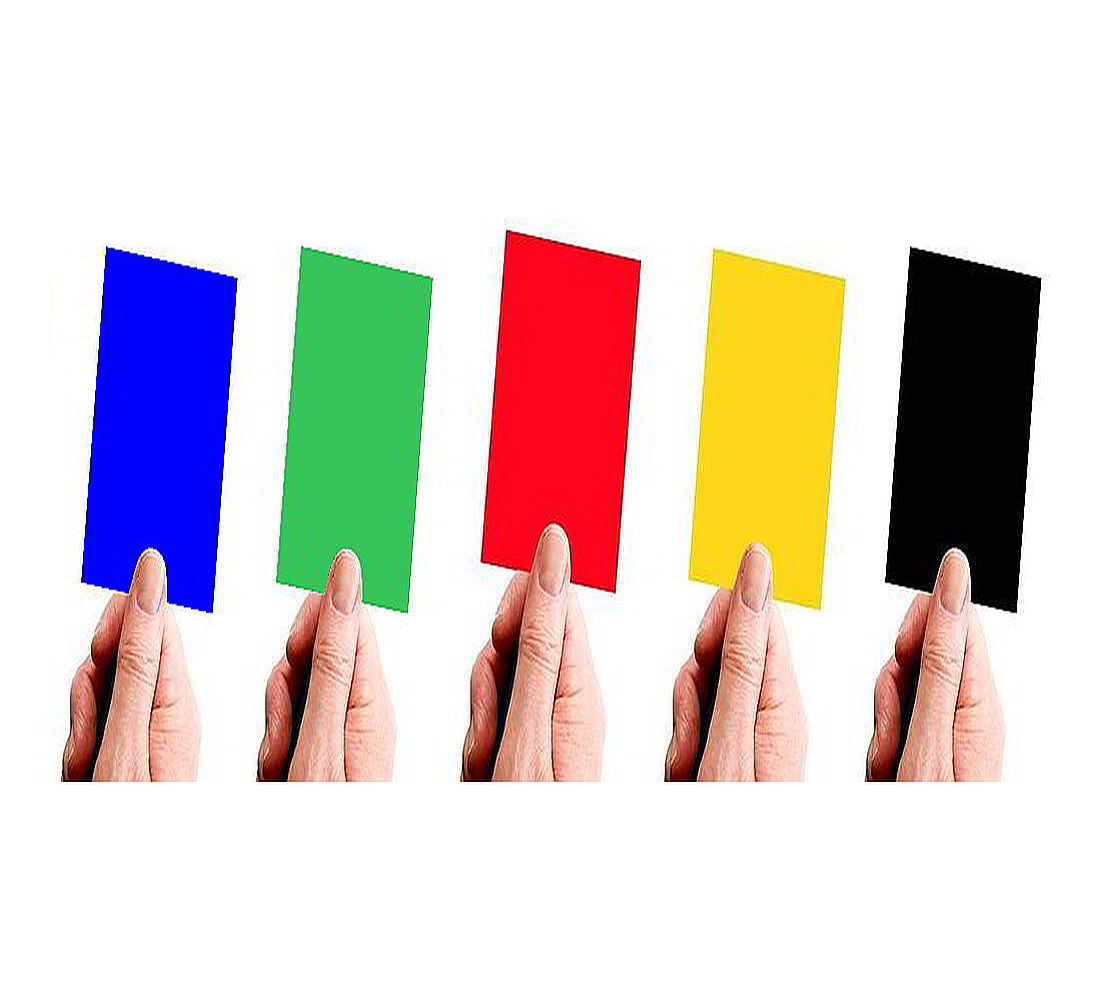Coloured Cards Voting
Main TakeawaysReading Time: 2 minutes Coloured Cards Voting is a simple version of the group decision Five-to-Fold facilitation for decision-making. A group has to decide in a very short time on a proposal and possible alternatives to solve the issue.
Description of Coloured Cards Voting
Coloured Cards Voting is a voting format to agree upon alternatives after they are discussed extensively. To create the alternative proposals for group decisions, there are other formats.
Coloured Cards Voting is a variant of Five Finger Voting which is a simple version of the group decision Five-to-Fold facilitation for decision-making. A group has to decide in a very short time on a proposal and possible alternatives to solve the issue.
The participants had debated extensively the proposal and it's alternatives in a discussion up-front. Now, it is time to decide. — You can vote with Five Fingers or with Coulored Cards.
When a group is asked to take a decision, the members try to find a common level of agreement by either democratic voting or consensus-based decision-making. In case of consensus-based decisioning seldom all people agree equally to the decision found. Instead, they commit themselves to a level of personal agreement.
Rules of Coloured Cards Voting
One out of the group
- Explains the issue shortly.
- Offers the solution.
- Fields questions — only short answers — no discussion.
- Asks the group for card voting:
- Black — Block: You want to block the proposal because you believe it’s damaging.
- Red — Abstain: You have important reservations but will support the initiative.
- Yellow — Stand Aside: You’re on board.
- Blue — Consent with Reservations: You give strong support and active participation, but you’re not willing to lead the initiative.
- Green — Full Agreement: You’re all-in and prepared to own the project. You’ll take the lead if asked.
Note:
- Folding is not a failure — its part of the process,
- Forced consensus drives dissent underground.
- Real consensus is never achieved by sacrificing your values or strongly held beliefs.
In case of dissent (i.e. three fingers and less) go back to Five-to-Fold facilitation:
- Remain flexible.
- Seek to be useful.
- Stay calm.
- Invite conversation.
- Address problems.
- Develop alternatives.
- Expand possibilities.
- Take another’s perspective.
- Clarify mission and vision.
- Explore options.
- Find acceptable levels of unity without browbeating dissenters.
When to use Coloured Cards Voting
- There is an issue to solve.
- There is a proposal (and alternatives) as a solution.
- There is a group, the participants, that has the authority to decide.
- There is only very short time.
Coloured Cards Voting
Main Takeaways
Reading Time: 2 minutes Coloured Cards Voting is a simple version of the group decision Five-to-Fold facilitation for decision-making. A group has to decide in a very short time on a proposal and possible alternatives to solve the issue.
Description of Coloured Cards Voting
Coloured Cards Voting is a voting format to agree upon alternatives after they are discussed extensively. To create the alternative proposals for group decisions, there are other formats. Coloured Cards Voting is a variant of Five Finger Voting which is a simple version of the group decision Five-to-Fold facilitation for decision-making. A group has to decide in a very short time on a proposal and possible alternatives to solve the issue.The participants had debated extensively the proposal and it's alternatives in a discussion up-front. Now, it is time to decide. — You can vote with Five Fingers or with Coulored Cards.
When a group is asked to take a decision, the members try to find a common level of agreement by either democratic voting or consensus-based decision-making. In case of consensus-based decisioning seldom all people agree equally to the decision found. Instead, they commit themselves to a level of personal agreement.
Rules of Coloured Cards Voting
One out of the group
- Explains the issue shortly.
- Offers the solution.
- Fields questions — only short answers — no discussion.
- Asks the group for card voting:
- Black — Block: You want to block the proposal because you believe it’s damaging.
- Red — Abstain: You have important reservations but will support the initiative.
- Yellow — Stand Aside: You’re on board.
- Blue — Consent with Reservations: You give strong support and active participation, but you’re not willing to lead the initiative.
- Green — Full Agreement: You’re all-in and prepared to own the project. You’ll take the lead if asked.
Note:
- Folding is not a failure — its part of the process,
- Forced consensus drives dissent underground.
- Real consensus is never achieved by sacrificing your values or strongly held beliefs.
In case of dissent (i.e. three fingers and less) go back to Five-to-Fold facilitation:
- Remain flexible.
- Seek to be useful.
- Stay calm.
- Invite conversation.
- Address problems.
- Develop alternatives.
- Expand possibilities.
- Take another’s perspective.
- Clarify mission and vision.
- Explore options.
- Find acceptable levels of unity without browbeating dissenters.
When to use Coloured Cards Voting
- There is an issue to solve.
- There is a proposal (and alternatives) as a solution.
- There is a group, the participants, that has the authority to decide.
- There is only very short time.








Leave A Comment